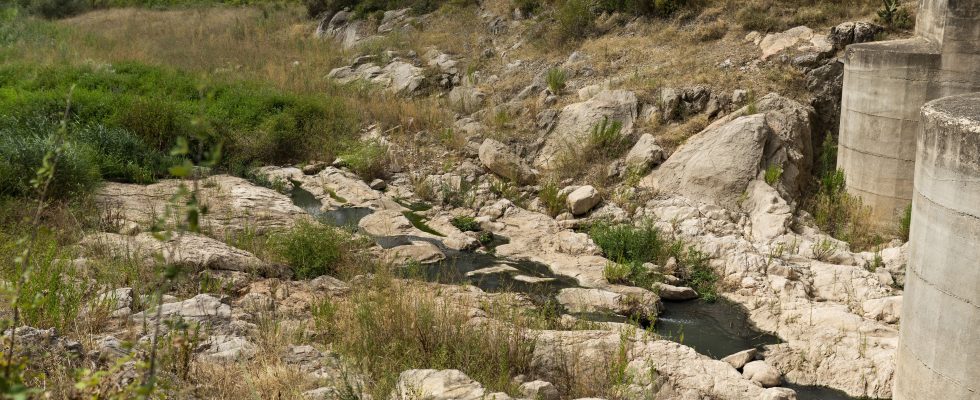They say no to bedpans. Thousands of people gathered this weekend in the Deux-Sèvres department, in Sainte-Soline, to demonstrate against these vast reservoirs dedicated to crop irrigation. The demonstration turned into a confrontation which left dozens of injured on the side of the police and demonstrators, with an activist between life and death on Sunday.
Projects for water reserves intended for agricultural irrigation, launched in the face of the threat of recurring droughts, are generating more and more tension around the question of the preservation and sharing of the resource. The record for consecutive days without rain recorded in January-February has reignited the debate between opponents and supporters of this model, at a time when Emmanuel Macron is pleading for a “water sobriety plan”.
Mega-basins exist in Europe, mainly in Spain. As reminded Release, Spain is a “superpower” of water reservoirs, called “embalses” or “pantanos”. According to the National Society of Dams and Water Reservoirs, which federates them, the country has 1,226, a record in Europe, especially in the semi-arid southern half of the country, which depends on it crucially for its agriculture.
The recourse of intensive agriculture to reservoirs is debated
Most were built between the 1950s, under a plan drawn up by the Franco regime, until the 1990s. But these water reservoirs have ceased to be considered a miracle solution. The context is known: that of the chronic shortage of water, partly linked to climate change but also to agricultural management.
As noted Release, in 2021, as part of a “national river restoration strategy”, 108 of these dams were destroyed, out of a total of 239 in the European Union. The objective is to rehabilitate a fluvial fauna in mound to the concrete walls of the dams. But the agricultural unions and the small farmers who made a living from it are protesting against this destruction.
While the rains are gradually decreasing, the water reserves continue to fall. These days, all the “embals” are at 51.7% of their capacity, according to the National Hydrological Plan, against 62.7% on average over the past decade.
“The agricultural pressure is so strong that the water reserves cannot be replenished from year to year”, estimates Julia Martínez, of the New Water Culture Foundation, interviewed by Release. Agriculture is indeed particularly greedy in resources: it uses 85 to 95% of what these water reservoirs offer, which had been designed to be able to develop agriculture intensively and without limits.
“Natural environments are in danger”
Contacted by EURACTIV, Joëlle Lallemand, president of the APIEEE (Association for the Protection, Information and Studies of Water and its Environment) believes that Spain shows what should not be reproduced in France. “They bet on the basins, now they can no longer fill them halfway. They have dried up the floors,” she laments.
Spain “only manages to fill them six out of ten years”, affirms to AFP Nicolas Girod, spokesman for the Confédération paysanne, a minority French agricultural union totally opposed to this process.
In Madrid, the Greenpeace office specifies with France 3 that the substitute water reserves and the diversions of rivers in the country are such that the system has reached a point of “unsustainable management”. “Natural environments are in danger. The Tagus is almost dead,” said Julio Barea, spokesman for Greenpeace. According to him, the country “has exceeded the natural capacities of water capture”, a phenomenon now “aggravated” by climate change.
In the semi-desert region of Aragon in northern Spain, a community of farmers in Tauste has been using the water substitute reserves for decades on an area of irrigated land of more than 80,000 hectares. One of its figures, trade unionist and farmer Javier Sanchez, believes with France 3 that the use of these basins is acceptable if water management remains “public” and “for all users”, “small or large operators”.
Desalination plants, an alternative solution?
Farmers claim to have adapted to this lack of abundance of water. The management of the resource is thus done on the scale of an entire community of users. Water is shared between farmers, industrialists and individuals, and “not reserved for a few”, underlines Javier Sanchez to France 3. A way of pointing out the difference, according to him, between the basins in France and the reserves in Spain, says this farmer who took part in a rally in Sainte-Soline last October.
“Normally there are no problems with water allocations at this time of the year. But at the moment they are redoing the allocation calculations and it is tight due to the lack of rain”, explains Javier Sanchez. The farmer must make a request and then a volume of water is allocated to him.
Faced with the lack of water, regional authorities are increasingly opting for desalination plants. Spain currently has 765 of them, 99 of which are large, specifies Release. In Catalonia, where the “embalses” are at their lowest historical level (27% of their capacity) and the drought persists, the regional government has decreed water restrictions and has invested 2.3 billion euros over five years. to double the capacity of the El Prat desalination plant, which has been running at full capacity since January 2022 to supply Barcelona and its metropolitan area. But these factories can only be established in places close to the sea and consume a lot of energy.
